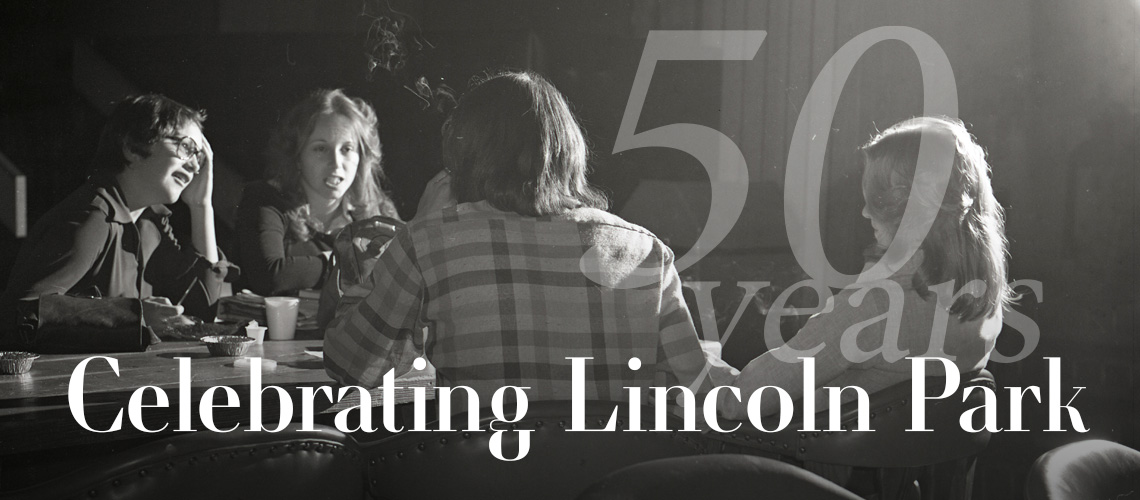
Words by Katherine Sharples
In 1972, Mount Royal’s main campus building opened and was a multi-purpose marvel of brutalist architecture with a ton of great characteristics.
Lincoln Park was erected in the middle of the site of a former airfield surrounded by military bases and flanked by two major roadways. It was a brand-new, modern “mega-structure,” writes former Mount Royal president (1980 to 1989) Donald Noel Baker in his book Catch the Gleam: Mount Royal, From College to University, 1910 to 2009. Architects worked to deliver a “high-quality academic shopping mall,” Baker says, and they succeeded, establishing a flexible learning space encompassing 60,121 square metres.
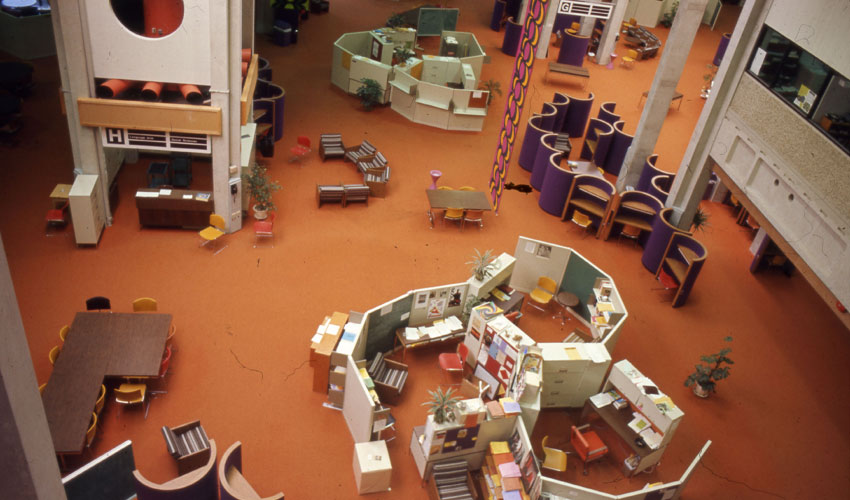
Mount Royal College's original Library was a flexible learning space with moveable furniture and an open floor plan.
Along with “huge open multi-purpose spaces and wide corridors,” the new Lincoln Park Campus building also housed an art gallery, a billiards hall, a fireside lounge, Dairy Bar, Pancake House, Pizza Place, Soup Kettle Inn, a gymnastics studio, a barber shop and hair salon and the campus favourite, the Rathskeller pub.
Officially opened on Nov. 17, 1972, with such dignitaries present as Howard P. Wright (the namesake for the Wright Theatre on campus), Leonard H. Leacock (Leacock Theatre), George D. Stanley (Stanley Gym), John Stevenson (Stevenson Plaza), Henry M. and Ronald H. Jenkins (Jenkins Theatre) and Dr. John H. Garden (Dr. John H. Garden Memorial Park), Lincoln Park began a new era of educational and cultural life in Calgary. Lieutenant Governor Grant McEwan and Premier Peter Lougheed were also in attendance.
"The students of MRC, feeling the cramped campus growing more crowded each month, decided on a course of action that took them to city hall with pickets declaring their case."
From the 1965 Mount Royal Varshicom yearbook.
The fight for a new campus
Mount Royal’s downtown campus was at peak capacity in 1964/1965. With 4,300 students registered, the original building, located at 1128 7 Ave. SW and affectionately nicknamed “The Barn,” plus four additional properties on the same block (added because of Mount Royal’s continuous growth), were no longer able to accommodate the College’s burgeoning population. Out of necessity, the then-junior college began looking for a way to expand.
In the 1965 Mount Royal yearbook, the Varshicom (the name recognizes the three fields of learning at the college, namely, university [varsity], high school and commercial) included an article titled “MRC campaigns for a new campus” explaining, “Due to the high cost of down town development, a suburban site would have been more suitable and when Lincoln Park was purchased by the city from the Federal government the college began to think of the possibility of establishing itself there. However, there were other contenders for the property. The Calgary Exhibition and Stampede Board also wants the site and began an expensive publicity campaign for the property. The students of MRC, feeling the cramped campus growing more crowded each month, decided on a course of action that took them to city hall with pickets declaring their case.”
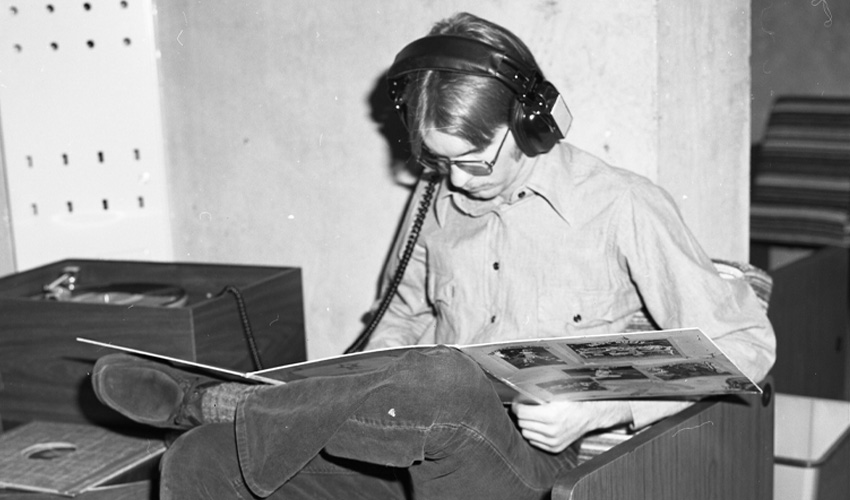
Among the educational offerings in 1972 were journalism and radio and television training.
This show of solidarity caused Calgary’s City Council to agree to sell 146 acres of the former Royal Canadian Air Force base to the provincial government for a combined tech-junior college campus for a total price of $373,030. The completed complex cost $15,101,010.
Joel Barrett, an architect from the firm Stevenson, Raines, Barrett, Hutton, Seton and Partners, which designed the original Lincoln Park building, noted his vision in a paper preserved in the Mount Royal University Archives and Special Collections located in the Riddell Library and Learning Centre. Barrett highlighted four areas: 1) the building form; 2) the building system; 3) interior environment; and 4) Mount Royal College — the programs.
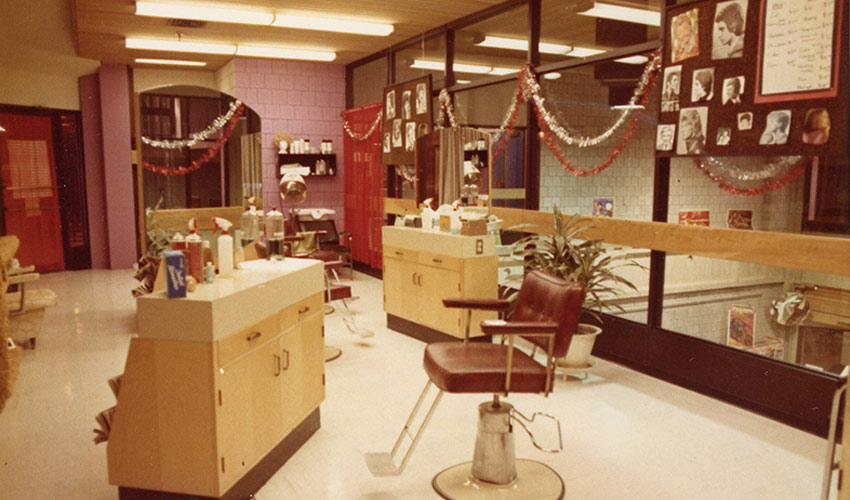
At College Mall Hair Styling — located between the Pancake House and the Soup Kettle Inn — a complete hairstyling cost $5 and cuts cost $3 and up, depending on length. A tapering was just $2.75.
In an excerpt, Barrett writes, “The building form is linear in concept but is developed around a stepped plaza court open on one side to the South sun, small pond and playfields, turning its back to the harsh North-West winds.
“The original technique used to relate these facilities was a linear mall, much like that of most North American shopping malls. Along this three-story mall were placed stairways, elevators and washrooms required to service the College. To the outer side of the mall are the flexible formal learning spaces. To the inner side of the mall are the more fixed informal learning and amenity spaces, the shopping, dining, lounge and recreational areas.”
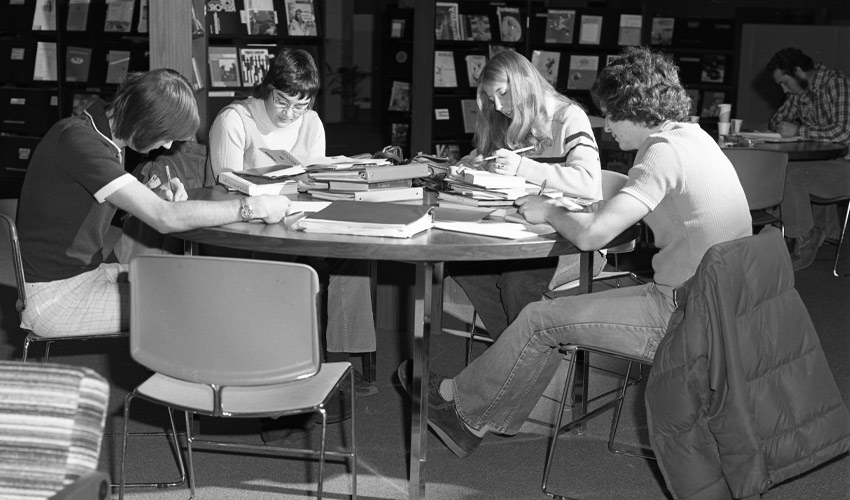
After a successful two years at Mount Royal College, students had the option of transferring to the University of Alberta.
The Archives and Special Collections holds a variety of records documenting the planning and construction of the Lincoln Park Campus, including photos, reports, campus newspapers and architectural drawings.
“Historical records like these are preserved by archives so that they can be used by current and future generations of students and researchers to learn about the past and to understand how today’s communities and their surroundings developed over time,” says Peter Houston, associate professor and archivist/librarian at Mount Royal.
The college that came first
As a community college with an “open-door” policy (the only requirement was that students must be 18 years old), the one- or two-year programs on offer at Lincoln Park were primarily in career-oriented fields such as secretarial arts, business administration, community service training, library clerical training, interior design, architecture, day care, industrial security, police science, stenography, journalism, and radio and television training. MRC was affiliated with the University of Alberta, where students could transfer after two years at the college.
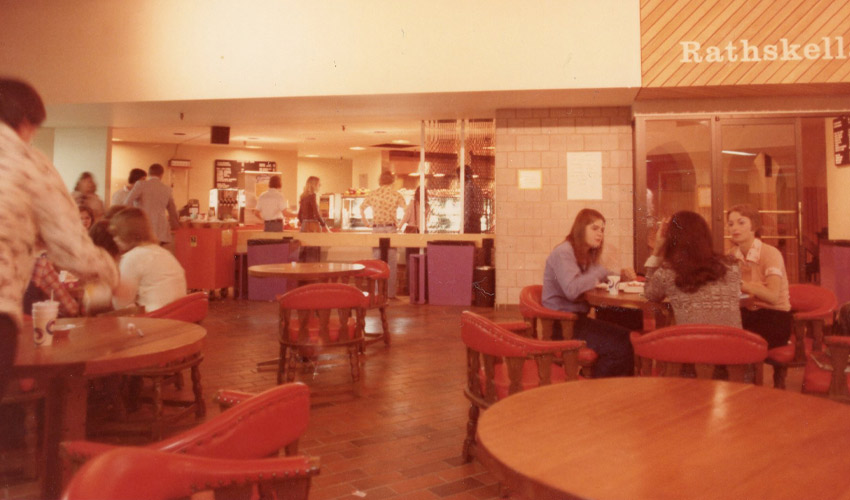
The Rathskeller was MRC’s first on-campus bar, located where Tim Hortons is now. It was decorated in German beer-hall style and often featured live music and performances. Photo courtesy Janet Brown, MRC photographer.
“The educational program for Mount Royal College attempts to provide an educational model and building form that can provide individualized programs, self-paced instruction, using problem-solving techniques, hand and computer monitored testing, adequate counselling, informal learning, in an interdisciplinary community of learners, community and related programs, and a home-base and recreation centre,” architect Barrett wrote.
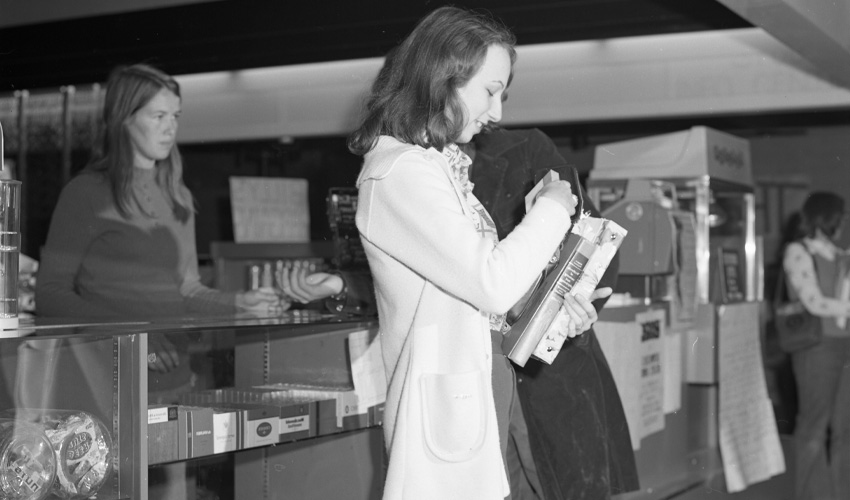
Mount Royal had to compete against the Calgary Exhibition and Stampede to win the land where it sits today.
With the new building, the Conservatory was able to expand its audience on the new campus through the construction of the 297-seat Leacock Theatre, and three other theatres (Ford, Jenkins and Wright) offered additional performance and lecture space.
“Every inch of the building suggests new ways of learning things … Physically, the move is a century jump,” wrote the Calgary Herald in 1972.
Fun facts
At College Mall Hair Styling — located between the Pancake House and the Soup Kettle Inn — a complete hairstyling cost $5 and cuts cost $3 and up, depending on length. A tapering was just $2.75.
Mount Royal College had to beat out several propositions for its land, including:
- The Calgary Exhibition and Stampede (Petition contained about 2,500 signatures)
- Industrial purposes or for an airport (Petitions contained 1,233 signatures of surrounding residents)
The Rathskeller was MRC’s first on-campus bar, located where Tim Hortons is currently. It was decorated in German beer-hall style and often featured live music and performances.
Take a deep dive into Lincoln Park’s history at mru.ca/LincolnArchives
Explore photographs and records held in Mount Royal University’s Archives & Special Collections in this archival display examining the reasons for Mount Royal College’s move away from downtown Calgary and the construction of Lincoln Park campus.
On Nov. 29, celebrate MRU Giving Day and 50 years at Lincoln Park campus. Join us as we raise critical funds for students through scholarship supports with an aim to grow our scholarship endowment pool to $50 million, making sure all students have access to a world-class undergraduate education.

